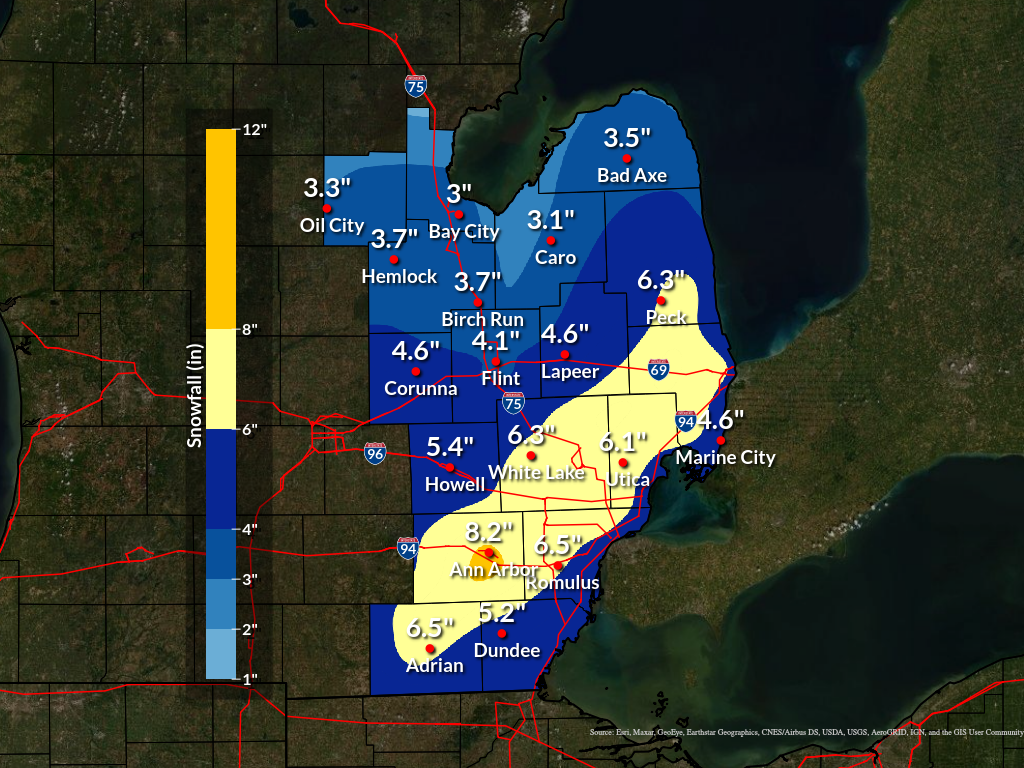Overview
Summary:A potent surface low pressure system organized over northern Mexico Monday night as it tracked into southern Texas Tuesday morning. Supporting upper low pressure phased with an energetic southern stream jet which enabled the system to lift rapidly northeastward while strengthening. Colder air on the northwestern flank of the surface low ensured a focused swath of snowfall from New Mexico, through the Ohio Valley, and into The Northeast by Thursday with persistent Gulf moisture feed. An initial round of snow driven by isentropic ascent began early Wednesday morning which spread from south to north across Southeast Michigan as the low crossed into the Mid-Mississippi Valley. This produced a coating of snow to around two inches by sunrise. The system’s meager dry slot then attempted to work in which led to a few breaks with mid-morning snowfall. Snow then resumed in full-force late Wednesday morning ahead of the heaviest banded features.
Heavy snowfall occurred midday Wednesday with strong frontogenetic circulations, elevated instability through the DGZ, and deformation forcing which produced large fluffy snowflakes and snowfall rates near one inch per hour at times. Thunder snow was observed just to the east over southern Lake St. Clair during the heaviest snowfall as the surface low approached Lake Erie Wednesday afternoon. Activity diminished quickly Wednesday evening as stabilization settled in behind the departing system which brought an abrupt end to the snow for most locations by 7 PM. Lake effect snow showers impacted portions of The Thumb and southern Huron shoreline areas into the overnight hours. Overall snow accumulations ranged from four to nine inches across the Winter Storm Warning area while amounts between two and four inches were realized elsewhere
Snow Totals
STORM TOTAL SNOW REPORTS
Location Snowfall Duration
(Inches) (Hours) Lat Lon
...Lenawee County...
Adrian M 5.2 M 41.90N 84.04W
Morenci M 6.0 M 41.72N 84.22W
Sand Creek M 7.0 13 41.83N 84.10W
Tecumseh M 7.0 13 42.01N 83.94W
Onsted M 8.0 13 42.01N 84.19W
...Monroe County...
Temperance M 4.0 M 41.77N 83.57W
Dundee M 5.2 M 41.96N 83.66W
1 SSW Ottawa Lake M 5.8 M 41.75N 83.76W
...Washtenaw County...
Manchester M 5.9 M 42.15N 84.04W
Ene Dexter M 6.0 M 42.33N 83.88W
5 NE Clinton M 6.2 M 42.12N 83.90W
5 W Plymouth M 8.0 M 42.37N 83.57W
2 WNW Ann Arbor M 8.1 M 42.29N 83.77W
Manchester M 8.1 13 42.15N 84.04W
4 SW Saline M 8.4 M 42.13N 83.84W
Ann Arbor M 8.8 M 42.28N 83.73W
...Wayne County...
2 NE Livonia M 5.5 M 42.42N 83.34W
1 NW Dearborn Heights M 6.2 M 42.34N 83.29W
2 NNW Livonia M 6.7 M 42.42N 83.39W
Romulus M 6.5 M 42.22N 83.37W
...Livingston County...
1 N Whitmore Lake M 4.8 M 42.44N 83.75W
Howell M 5.4 M 42.61N 83.94W
...Oakland County...
5 E Holly M 4.2 M 42.80N 83.52W
2 S Ortonville M 4.6 M 42.82N 83.44W
E White Lake M 5.7 M 42.65N 83.50W
1 SW Clarkston M 5.9 M 42.73N 83.43W
3 S Bloomfield Township M 6.0 M 42.53N 83.26W
4 E White Lake M 6.1 M 42.65N 83.43W
Farmington M 6.2 M 42.46N 83.38W
2 NNW Wixom M 6.4 M 42.55N 83.55W
1 ENE Lake Orion M 7.2 M 42.79N 83.23W
...Macomb County...
Mount Clemens M 4.9 M 42.60N 82.88W
1 ENE Roseville M 5.3 M 42.51N 82.92W
2 NNE Sterling Heights M 7.0 M 42.61N 83.02W
Shelby Township M 7.3 M 42.67N 83.03W
Sse Shelby Township M 7.3 M 42.67N 83.03W
Nnw Richmond M 7.6 M 42.81N 82.75W
...Shiawassee County...
Durand M 4.0 M 42.91N 83.99W
Owosso M 4.3 M 43.00N 84.18W
6 WNW Durand M 4.5 M 42.95N 84.10W
...Genesee County...
4 SSW Flint M 3.8 M 42.97N 83.72W
Burton M 3.8 M 43.00N 83.62W
Grand Blanc M 3.8 M 42.93N 83.62W
4 N Burton M 4.1 M 43.05N 83.62W
2 SE Grand Blanc M 4.9 M 42.91N 83.59W
...Lapeer County...
Lapeer M 3.0 M 43.05N 83.32W
Lapeer M 3.3 M 43.05N 83.32W
...St. Clair County...
Algonac M 5.0 M 42.62N 82.53W
Port Huron M 5.1 M 42.99N 82.43W
2 W Port Huron M 7.0 12 42.99N 82.47W
2 S Adair M 8.0 M 42.77N 82.63W
...Saginaw County...
4 S Auburn M 2.9 M 43.54N 84.08W
Saginaw M 3.0 M 43.42N 83.95W
...Tuscola County...
Caro M 2.5 M 43.49N 83.40W
Vassar M 3.0 M 43.37N 83.58W
Cass City M 3.5 M 43.60N 83.18W
...Sanilac County...
Roseburg M 6.0 12 43.19N 82.74W
Croswell M 6.8 12 43.27N 82.62W
...Midland County...
Oil City M 3.1 M 43.61N 84.59W
4 SE Midland M 3.4 12 43.58N 84.17W
...Bay County...
Auburn M 3.6 M 43.60N 84.08W
...Huron County...
5 NNW Filion M 3.4 M 43.96N 83.04W
Bad Axe M 3.7 M 43.80N 83.00W
Port Austin M 4.0 M 44.04N 83.00W
M = Measured
E = Estimated
$$

Radar
| Radar: NEXRAD mosaic base reflectivity radar loop from 11:30 PM Jan 24, 2023 through 8 PM Jan 25, 2023. |
Environment
|
|
|
| Figure 1: 12z DTX Sounding | Figure: WPC surface analysis map at 1 PM Jan 25, 2023. |
| Figure: 300 mb level height (black contours - m MSL), wind speed (fill - knots), and convergence (pink contours - 10^-5/s) at 1 PM Jan 25, 2023. |
|
|
|
| Figure: Dendritic Growth Zone (-12C to -17Z) depth (contour - m) & RH (fill - %) at 1 PM Jan 25, 2023. | Figure: Mid-level (700-500 mb) lapse rates (contour - J/kg) at 3 PM Jan 25, 2023. |
 |
Media use of NWS Web News Stories is encouraged! Please acknowledge the NWS as the source of any news information accessed from this site. |
 |